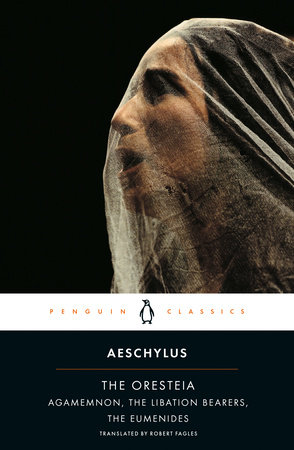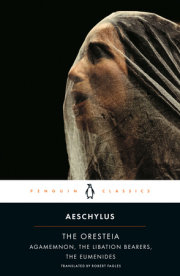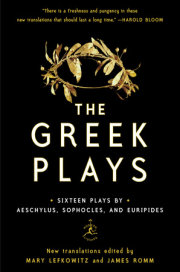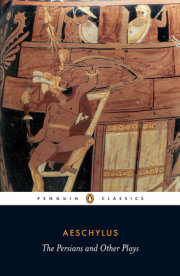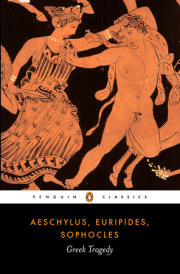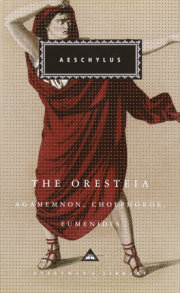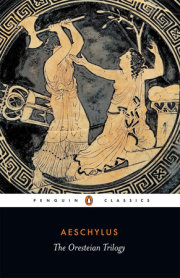Table of Contents
THE ORESTEIA AGAMEMNON, THE LIBATION BEARERS, THE EUMENIDES
Title Page
Copyright Page
Foreword
Acknowledgements
AGAMEMNON
THE LIBATION BEARERS
THE EUMENIDES
THE GENEALOGY OF ORESTES
SELECT BIBLIOGRAPHY
NOTES
GLOSSARY
FOR THE BEST IN PAPERBACKS, LOOK FOR THE
PENGUIN CLASSICS
THE ORESTEIA AGAMEMNON, THE LIBATION BEARERS, THE EUMENIDES
AESCHYLUS was born of a noble family at Eleusis near Athens in 525 B.C. He took part in the Persian Wars and his epitaph, said to have been written by himself, represents him as fighting at Marathon. At some time in his life he appears to have been prosecuted for divulging the Eleusinian mysteries, but he apparently proved himself innocent. Aeschylus wrote more than seventy plays, of which seven have survived: The Suppliants, The Persians, Seven Against Thebes, Prometheus Bound, Agamemnon, The Libation Bearers, and The Eumenides. (All are translated for Penguin Classics.) He visited Syracuse more than once at the invitation of Hieron I and he died at Gela in Sicily in 456 B.C. Aeschylus was recognized as a classic writer soon after his death, and special privileges were decreed for his plays.
ROBERT FAGLES is Arthur W. Marks ’19 Professor of Comparative Literature, Emeritus, at Princeton University. He is the recipient of the 1997 PEN/Ralph Manheim Medal for Translation and a 1996 Academy Award in Literature from the American Academy of Arts and Letters. Fagles has been elected to the Academy, the American Academy of Arts and Sciences, and the American Philosophical Society. He has translated the poems of Bacchylides. His translations of Sophocles’ Three Theban Plays, Aeschylus’ Oresteia (nominated for a National Book Award) and Homer’s Iliad (winner of the 1991 Harold Morton Landon Translation Award by The Academy of American Poets, an award from The Translation Center of Columbia University, and the New Jersey Humanities Book Award) are published in Penguin Classics. His original poetry and his translations have appeared in many journals and reviews, as well as in his book of poems, I, Vincent: Poems from the Pictures of Van Gogh. Mr. Fagles was one of the associate editors of Maynard Mack’s Twickenham Edition of Alexander Pope’s Iliad and Odyssey, and, with George Steiner, edited Homer : A Collection of Critical Essays. Mr. Fagles’ most recent work is a translation of Homer’s Odyssey, available from Penguin.
The late W B. STANFORD was Senior Fellow of Trinity College Dublin and Regius Professor of Greek at Dublin University, where he became Chancellor. His several works include the acclaimed Ulysses Theme, definitive editions of Homer’s Odyssey, Sophocles’ Ajax and Aristophanes’ Frogs, Aeschylus in His Style, pioneering studies of metaphor and ambiguity in Greek poetry, and The Sound of Greek, Greek Tragedy and the Emotions, and with J.V. Luce, The Quest for Ulysses. Stanford served as representative of Dublin University in the Senate of the Irish Republic from 1948 to 1969 and as chairman of the Dublin Institute for Advanced Studies beginning in 1972.
PENGUIN BOOKS
Published by the Penguin Group
Penguin Group (USA) Inc., 375 Hudson Street, New York, New York 10014, U.S.A.
Penguin Group (Canada), 90 Eglinton Avenue East, Suite 700, Toronto,
Ontario, Canada M4P 2Y3 (a division of Pearson Penguin Canada Inc.)
Penguin Books Ltd, 80 Strand, London WC2R 0RL, England
Penguin Ireland, 25 St Stephen’s Green, Dublin 2, Ireland (a division of Penguin Books Ltd)
Penguin Group (Australia), 250 Camberwell Road, Camberwell,
Victoria 3124, Australia (a division of Pearson Australia Group Pty Ltd)
Penguin Books India Pvt Ltd, 11 Community Centre, Panchsheel Park,
New Delhi - 110 017, India
Penguin Group (NZ), 67 Apollo Drive, Mairangi Bay, Auckland 1311,
New Zealand (a division of Pearson New Zealand Ltd)
Penguin Books (South Africa) (Pty) Ltd, 24 Sturdee Avenue, Rosebank,
Johannesburg 2196, South Africa
Penguin Books Ltd, Registered Offices: 80 Strand, London WC2R 0RL, England
First published in the United States of America by
Viking Penguin Inc. 1975
First published in England by
Wildwood House Ltd 1976
Published in the Penguin Classics 1977
Reprinted with revisions 1979
Copyright © Robert Fagles, 1966, 1967, 1975, 1977
All rights reserved
LIBRARY OF CONGRESS CATALOGING IN PUBLICATION DATA
Aeschylus.
The Oresteia.
Bibliography: p.
I. Fagles, Robert. II. Title.
PA3827.A7F.01 83-17421
eISBN : 978-1-101-04263-2
All dramatic, motion picture, radio, television, and other rights in this translation are fully protected by all signatories to the Universal Copyright Convention, and no public or private performances—professional or amateur—may be given without written permission of the copyright owners. All inquiries shall be addressed to the copyright owners c/o Georges Borchardt, Inc., 136 East 57th Street, New York, New York 10022.
Illustrations by Sylvia Allman
The scanning, uploading and distribution of this book via the Internet or via any other means without the permission of the publisher is illegal and punishable by law. Please purchase only authorized electronic editions, and do not participate in or encourage electronic piracy of copyrighted materials. Your support of the author’s rights is appreciated.
FOREWORD
My thanks to Aeschylus for his companionship, his rigours and his kindness. I found him a burly, eloquent ghost, with more human decency and strength than I could hope to equal. As I tried to approach him, I remembered what they said of the ghost of Hamlet’s father: ‘We do it wrong, being so majestical, To offer it the show of violence.’ Translation has its violent moments, and I suppose it must. It begins with attraction, then a kind of attack, and it ends, if you are lucky, with a strong impersonation of your author. Whatever the end, at any rate, it is meant to be a thing of love and homage. So in thanking that proud old spirit, I would also ask for his forbearance, if he should ever hear what I have written in his name.
Now it is time to let this version of the Oresteia speak for itself, without apologies or statements of principle (petards that will probably hoist the writing later). A translator’s best hope, I think, and still the hardest to achieve, is Dryden’s hope that his author will speak the living language of the day. And not in a way that caters to its limits, one might add, but that gives its life and fibre something of a stretching in the process. In translating Aeschylus I have also tried to suggest the responsion of his choral poetry - the paired, isometric stanzas that form the dialectic dance and singing of his plays in Greek - but I have done so flexibly. and using English rhythms. The translation has its leanings, too, yet they are loyal to Aeschylus, at least as I perceive him, and loyal to the modem grain as well. There is a kinship between the Oresteia and ourselves; a mutual need to recognize the fragility of our culture, to restore some reverence for the Great Mother and her works, and especially to embrace the Furies within ourselves, persuading them, perhaps, to invigorate our lives. I hope this kinship can be felt in the English text and supported by the introductory essay.
The essay begins and ends with broader, general sections; in between come more detailed descriptions of each play. The final version of the introduction is my own, particularly the freer conjectures about images and symbols, the moral power of the Furies, and the psychological and religious dimensions of the Oresteia. My collaborator, W. B. Stanford, has supplied accounts of the dramatic action and a good deal of historical and linguistic material - the discussion of the watchman, Clytaemnestra’s third speech, and her crucial exchanges with Agamemnon and the elders. The passages on technique owe much to him, to what he has written for the purpose, and his books on Greek metaphor, ambiguity, and Aeschylus in His Style. As we indicate later, we have shared the writing of the notes. We have relied on Fraenkel’s edition of Agamemnon with few exceptions, on Murray’s of The Libation Bearers and The Eumenides with help from other scholars. (Unfortunately Denys Page’s new edition of Aeschylus arrived too late for us to use). Marginal line numbers refer to the English while those at the head of each page refer to the original Greek. We have kept the English or Latin forms of the most familiar proper names, but have transliterated the rest.
I could not have done my part without the help of many people. Bedell Stanford first, of course. He offered me what I have needed most, Ionic tolerance and Doric discipline. So much patience with my questions, so many cautions to revise - he has been the brake to my locomotive, in his phrase, and the conscience of Aeschylus in mine. Before they met their deaths in June 1971, my friends Anne and Adam Parry often came to my rescue with their knowledge, comradeship and warmth. Robert Fitzgerald helped me on many points, even as late as the galleys of the first edition, with his Homeric magnanimity and tact. Kenneth Burke taught me that The Eumenides is less tragic than I had thought, and less transcendental than he would like. And the one who led me to translate the Oresteia gave me his painstaking, strenuous criticism of the opening play, its notes and introduction. He would rather not be named; I owe him more than I can say.
Others have helped as well, with advice or encouragement or both. The list is long because the work was long, and they were very generous. Some are gone now - Alan Downer, Dudley Fitts, Erich Kahler, Robert Murray, Jr, and Fred Wieck. But many more remain: Donald Carne-Ross and the staff of Arion, where parts of the translation first appeared; Patricia Purcell Chappell, Julius Cohen, Robert Connor, Mark Davies, Francis Fergusson, Joseph Frank, Georgine and Ralph Freedman, Caroline Gordon, Edmund Keeley, Bernard Knox, Hanna Loewy, Maynard Mack, Mary Renault, Erich Segal, George Steiner, Dorothy Thompson, Kathryn Walker, Rex Warner, Theodore Weiss, and Theodore Ziolkowski.
My students ought to know how much I have learned about tragedy from them. I think of William Abernathy, Louis Bell, Kathleen Costello, James Donlan, Ruth Gais, Katherine Callen King, Kathleen Komar, David Lenson, James McGregor, Robert Scanlan, Celeste Schenck, Janet Levarie Smarr and Macklin Smith. And I remember the brave actors who performed an early version of Agamemnon at McCarter Theatre in 1966, Angela Wood, and George and Susan Hearn. Princeton University granted me leaves of absence to work on Aeschylus, and the Research Committee freely saw to my expenses.
This is a new edition of the book, and I want to thank the ones who made it possible. Primarily my editor, Will Sulkin, for his precision and concern, and the good people at Penguin Books who believe that Aeschylus should have a broad appeal. Georges Borchardt and Richard Simon poured the wine and sped the work once more. And my first hosts in England, Dieter Pevsner and Oliver Caldecott of Wildwood House - like my host in America, Alan Williams of The Viking Press - cared for this Oresteia as if it were their own. Without their kindness it might never have seen the light.
Thanks above all to Lynne, abiding thanks and more -
R.F
Princeton, New Jersey
September 1976
ACKNOWLEDGEMENTS
Harcourt Brace Jovanovich, Inc., and Faber and Faber Ltd: From ‘The Dry Salvages’ and ‘East Coker’ from Four Quartets by T. S. Eliot.
Liveright Publishing Corp.: From ‘The Dance’ from The Collected Poems and Selected Letters and Prose of Hart Crane by Hart Crane. Copyright © 1933, 1958, 1966 by Liveright Publishing Corp. Reprinted by permission of Liveright Publishing, New York.
Macmillan Publishing Co. Inc., M. B. Yeats and the Macmillan Company of London & Basingstoke, and the Macmillan Company of Canada: From ‘To Dorothy Wellesley’ from Collected Poems by William Butler Yeats. Copyright © 1940 Georgie Yeats, renewed 1968 by Bertha Georgia Yeats, Michael Butler Yeats and Anne Yeats. From ‘Two Songs from a Play’ from Collected Poems by William Butler Yeats. Copyright © 1928 by Macmillan Publishing Co. Inc., renewed 1956 by Georgie Yeats.
The New American Library, Inc.: From Lucretius: On the Nature of Things, translated by Palmer Bovie and published by The New American Library. Reprinted by permission of The New American Library.
The Viking Press, Inc., Laurence Pollinger Limited and the Estate of Mrs Frieda Lawrence, and William Heinemann Limited: From The Collected Letters of D. H. Lawrence, edited by Harry T. Moore. Copyright © 1962 by Angelo Ravagli and C. Montague Weekley. All rights reserved. Reprinted by permission.
Yale University Press: From The Earth, the Temple, and the Gods: Greek Sacred Architecture by Vincent Scully (New Haven and London, 1962).
A READING OF ‘THE ORESTEIA’
THE SERPENT AND THE EAGLE
Now is the strong prayer folded in thine arms,
The serpent with the eagle in the boughs.
HART CRANE, The Dance
AESCHYLUS was forty-five in 480 B.C. when the Persians sacked Athens and destroyed the shrines of the gods on the Acropolis. Soon afterwards he fought in the forces which defeated the Persians at Salamis and Plataea, as he had fought in the Greek victory at Marathon ten years before. The Greeks in general, and the Athenians in particular, because they had played the major part in the triumph of Hellas, saw these victories as a triumph of right over might, courage over fear, freedom over servitude, moderation over arrogance. After their struggle the people of Athens entered upon a spectacular era of energy and prosperity, one of the great flowering periods of Western civilization. Physically the two noblest monuments of that age were the Parthenon of Ictinos and Pheidias, and the Oresteian trilogy of Aeschylus. Paradoxically, when one considers the contrast between the durability of marble and the fragility of papyrus, the Oresteia is better preserved by far. But both were expressions of optimism as well as of artistic genius. Out of the savagery of past wars and feuds a new harmony - religious, political, and personal - might be created. Perhaps Athens would achieve what public-spirited men and women have always longed for, a peaceful, lawful community, a city of benevolent gods and beneficent men. Within fifty years of the Persian defeat the dream had faded, and before the end of the century Athens, over-extended abroad and over-confident at home, lay defeated at the mercy of her enemies, a Spartan garrison posted on the Acropolis and democracy in ruins. Much in the intervening years had been magnificent, it is true, but so it might have remained if the Athenians had heeded Aeschylus. As early as The Persians he had portrayed the Greek victory as a triumph over the barbarian latent in themselves, the hubris that united the invader and the native tyrant as targets of the gods. Their downfall, like the downfall of Agamemnon, called not only for exultation but for compassion and lasting self-control.
The Oresteia perfects this vision of warning and reward. Athenian exhilaration still ran strong in 458 when Aeschylus, at the age of sixty-seven, produced his trilogy. It breathes the buoyant spirit of his city. Its dominant symbolism is that of light after darkness. Beginning in the darkness-before-dawn of a Mycenaean citadel benighted by curses and crimes, it ends with a triumphant torchlit procession in an Athens radiant with civic faith and justice. The entire drama is one long procession, and each step brings us closer to the light. Originally the Oresteia consisted of four plays - Agamemnon, The Libation Bearers, The Eumenides and Proteus. The last was a satyr-play, completing the full ‘tetralogy’ dramatists composed. It would have presented gods and heroes in a comic situation that relieved the tensions of the tragedies while illuminating them with fresh perspectives. The Proteus has not survived, but the three tragedies form a unity in themselves, the only complete Greek trilogy we have, and its scope is as expansive as an epic. Aeschylus referred to his work as ‘slices from the banquet of Homer’, but his powers of assimilation were impressive. His trilogy sweeps from the Iliad to the Odyssey, from war to peace. Yet it was the darker events of the Odyssey - the murder of Agamemnon by his wife and the vengeance of his son, Orestes - that inspired Aeschylus to produce a great tale of the tribe. He deepened Homer with even older, darker legends and lifted him to a later, more enlightened stage of culture.
Let us recall the outlines of the tale. The house of Atreus is the embodiment of savagery. No other Greek family can rival it for accumulated atrocities. The founder of the line was Tantalus of Lydia, a barbarian whose spirit haunts the Oresteia. He offended the gods by feasting them on his son’s flesh, and they condemned him to starve in Hades, ‘tantalized’ by the drink and luscious fruits just out of reach. But they restored his victim, Pelops, to a new, resplendent life. Later he went to western Greece, where he won the hand of Hippodameia by a ruse which killed her father - a murderous chariot race which may have been the origin of the Olympic games. Pelops had two sons, Atreus and Thyestes. When Thyestes seduced his brother’s wife and contested his right to the throne, Atreus banished him and then, luring him back for a reconciliation, feasted him on his children’s flesh. Horrified, Thyestes cursed Atreus and his descendants and fled into exile once again, accompanied by his one remaining son, Aegisthus. Atreus had two sons, Agamemnon and Menelaus, who jointly inherited the realm of Argos and married two daughters of Tyndareos, Clytaemnestra and Helen. Agamemnon became the commander-in-chief of the Greek forces that attacked Troy to avenge the seduction of Helen by Paris, son of Priam. At the outset of the expedition, however, Agamemnon had to sacrifice his and Clytaemnestra’s daughter Iphigeneia - a fact that Homer had omitted, perhaps to exonerate the king for an aristocratic audience - and so he becomes an agent of the curse upon his house.
The action of the Oresteia begins more than nine years later, just after the fall of Troy and Agamemnon’s seizure of Cassandra, the daughter of Priam and priestess of Apollo, whom he abducts to Argos as his mistress. The Agamemnon describes how Clytaemnestra kills her husband for the death of their daughter and the insult of Cassandra, and establishes herself and Aegisthus, her paramour and also the avenger of his father, as rulers over Argos. It is not a case of right against wrong as it is in Homer; it demonstrates Nietzsche’s motto for Aeschylean tragedy: ‘All that exists is just and unjust and equally justified in both’ (in Walter Kaufmann’s translation). And its sequel erupts into a moral struggle never told by Homer. In The Libation Bearers the only son of Agamemnon and Clytaemnestra, Orestes, obeys the command of Apollo and kills the murderers in revenge; but his mother’s Furies drive him mad and in the final play, The Eumenides, pursue him to Apollo’s shrine at Delphi. The god can purify Orestes of blood-guilt but cannot release him from the Furies and refers him to Athens and Athena for their judgement. There the goddess appoints a group of men to conduct a trial for manslaughter and so establishes the Areopagus, her famous court of law. Orestes is acquitted and restored to his fathers’ lands in Argos, while Athena persuades the Furies, the demons of the primitive vendetta-law, to become benevolent patrons, changing their names to ‘Eumenides’, the Kindly Ones of Athens. The final choruses are in the mood of Beethoven’s Hymn to Joy: let us rejoice, the spirit of man has triumphed over the harsher elements of life—a new order has been born.
What Aeschylus builds upon the house of Atreus is ‘a grand parable of progress’, as Richmond Lattimore has described it, that celebrates our emergence from the darkness to the light, from the tribe to the aristocracy to the democratic state. At the same time Aeschylus celebrates man’s capacity for suffering, his courage to endure hereditary guilt and ethical conflicts, his battle for freedom in the teeth of fate, and his strenuous collaboration with his gods to create a better world. The tragic burden of the Iliad is magnified, then channelled into the battle of the Odyssey, the battle to win home. Aeschylus is optimistic, but he would agree with Hardy: ‘if way to the Better there be, it exacts a full look at the Worst.’ How had we come so far? he asks. Through struggle, and through struggle we will advance. Zeus, as the old men of Argos tell us, ‘lays it down as law/that we must suffer, suffer into truth.’ Perhaps no paradox inspired Aeschylus more than the bond that might exist between pathos and mathos, suffering and its significance. That bond is life itself. Reflect on the house of Atreus, what’s more, on Pelops’ regeneration from the cauldron, on the rise of the Olympic games from an act of murder, on the establishment of the Areopagus in response to Orestes’ matricide, and that bond produces our achievements—pain becomes a stimulus and a gift. This commitment to suffering not only as the hallmark of the human condition but as the very stuff of human victory lends the Oresteia its perennial appeal. But it does not speak to certain later, more spiritual ages which sublimate our anguish into ‘the blest Kingdoms meek of joy and love’. Aeschylus speaks to a world more secular, to some more dangerous, more exhilarating, more real. He would say with Keats, ‘Do you not see how necessary a World of Pain and troubles is . . . ? A Place where the heart must feel and suffer in a thousand diverse ways! . . . thus does God make individual beings, Souls, Identical Souls of the sparks of his own essence—This appears to me a faint sketch of a system of Salvation which does not affront our reason and humanity.’
The suffering of Atreus and his sons is a very old and yet a very modern matter. They are less removed from us than we might like to think. They are cursed, their lives are an inherited disease, a miasma that threatens the health of their community and forces them, relentlessly, to commit their fathers’ crimes. It is as if crime were contagious - and perhaps it is - the dead pursued the living for revenge, and revenge could only breed more guilt. For such guilt is more than criminal; it is a psychological guilt that modem men have felt and tried to probe. Every crime in the house of Atreus, whether children kill their parents or parents kill their children and feed upon their flesh, is a crime against the filial bond itself. So dominant is the pattern, in fact, that E. R. Dodds and others say that such mythology reflects the pathology of a culture ridden by its guilt. This is a subject that psycho-historians may explain; we can only allude to its vaguest generalities here. What the members of that culture may have fantasized and repressed, creating a pressure of recrimination in themselves, the sons of Atreus, their surrogates, have acted out with relish and abandon. They have heard Blake’s Proverb of Hell: ‘Sooner murder an infant in its cradle than nurse unacted desires.’ Those desires rose to a fever pitch, some surmise, between Homer and the age of tragedy. Whatever conflicts caused them - the miseries of existence that might seem to set the dead against the living; or historical upheavals, the economic crisis of the seventh century that unleashed the class warfare of the sixth; or emotional tensions bred by the breaking-up of family solidarity - a people felt themselves in the grip of an angry father-god. His injustice was their fate; his judgement was the measure of their guilt.
They sought escape in the purges of Apollo, a god of self-restraint. They appealed to his opposite, Dionysus, a god of ecstasy who may have promised more. We will never be certain of his nature - what follows is sheer conjecture - but our intimations point to a god of paradox. Dionysus, son of Zeus and a mortal woman, Semele, was born of the earth and yet is always striving for the sky. Originally he was a god of fertility, even of life in all its contradictions, blasting us and blessing us at once. He was the menace of existence turning fruitful and, as the god of wine, leading us to joy. His spirit well might rule the house of Atreus, its atrocities and its achievements. For the rites of Dionysus could include the rending of living creatures and feeding on their flesh; yet his rites were horrible and holy too, as Dodds suggests, and through them his communicants could absorb his vital gifts. He is the god who dies, the hunter who is hunted, the render who is rent - but all to be reborn. According to one legend Hera was enraged that Semele had borne the child-god by Zeus; she commanded the Titans to tear him limb from limb and eat him raw. So they did, and Zeus consumed them with lightning and Dionysus with them. But he was restored, and from the Titans’ ashes with their residue of his blood the race of man sprang forth, part Titan and part god, rage and immortal aspiration fused.
Through Dionysus, in other words, men might be restored, not by escaping their nature but by embracing it, not by expiating their guilt but by exercising it constructively. Here was a father, an authority who challenged us to challenge him. Only by acting out our fantasies against him - by ritualistically dismembering his body and partaking of his strength - could we become ourselves, human, seasoned, strong. Perhaps that is why he lashed a guilty age into a dance of life as irresistible as St Vitus’ dance in time of plague. He was health and more; his euphoria led to better realms of being. By the time of Aeschylus, some believe, Dionysus had become the god of the senses straining towards a religious affirmation. His worship was a return to nature led by sensible, sophisticated men who reached for the world in its primitive aspect - its innocence, its terror, its powers of renewal - not as a cue for madness but as an incentive for their culture. The ecstasy of Dionysus became ennobling. He became Olympian; he shared Apollo’s shrine at Delphi. The suffering god was transformed into a saviour, but not in the way of later martyrs who reject this life. Dying into life, into more coherent, vibrant forms of life was the way of Dionysus and his people.
They communed through tragedy, ‘a terrible sacrament of the god’, as Yeats imagined it. Tragedy was created for Dionysus’ rites of spring in Athens and was performed in his theatre on the southern slopes of the Acropolis. The ritual origins of tragedy are totally in doubt, often hotly contested. We will merely suggest how certain rites may still exist within the Oresteia, not as rituals in themselves, religiously observed, but freely adapted to the point of sacred parody, re-created and recast by Aeschylus’ distinctive tragic vision. For while these rituals may reflect the growth of Dionysus from a spirit of the year to the spirit of human culture, they dramatize, continually, his tragic spirit of suffering and regeneration. Throughout the trilogy we may feel the sunrise breaking from the night or the seasons wheeling in their rounds, the winter yielding to the spring that leads again to harvest. Even more deeply, we may sense what the early tribe inferred from the making of the year: the making of a man, his rites of passage. Such rituals are ordeals, painful strides from loss to gain that mark a person at the crises of his life - puberty, marriage, death - and unite him with a larger set of values, his mate, his society, the ancestral dead. Yet the Oresteia far exceeds the customary trilogy of tribal rites of passage. The Agamemnon is like the rite of separation; the king is cut off from his society. The Libation Bearers is like the rite of transition; the son is at the threshold of maturity. But The Eumenides, the rite of aggregation, celebrates Orestes’ initiation into Argos and our initiation into Athens.
The Oresteia is our rite of passage from savagery to civilization. What strengthens this impression are the specific rituals that may stir within the trilogy. In debates about the origins of tragedy, they are among the main contenders: the rituals of the dying god, the hero cult and the legal trial. Consider each in turn. The Athenians who gathered in the Theatre of Dionysus may have assembled for a passion play, as a congregation assembles at Easter, to worship the god whose death releases vital energies; to see, in Yeats’s words,
a staring virgin stand
Where holy Dionysus died,
And tear the heart out of his side,
And lay the heart upon her hand
And bear that beating heart away;
And then did all the Muses sing
Of Magnus Annus at the spring,
As though God’s death were but a play.
. All rights reserved. No part of this excerpt may be reproduced or reprinted without permission in writing from the publisher.

